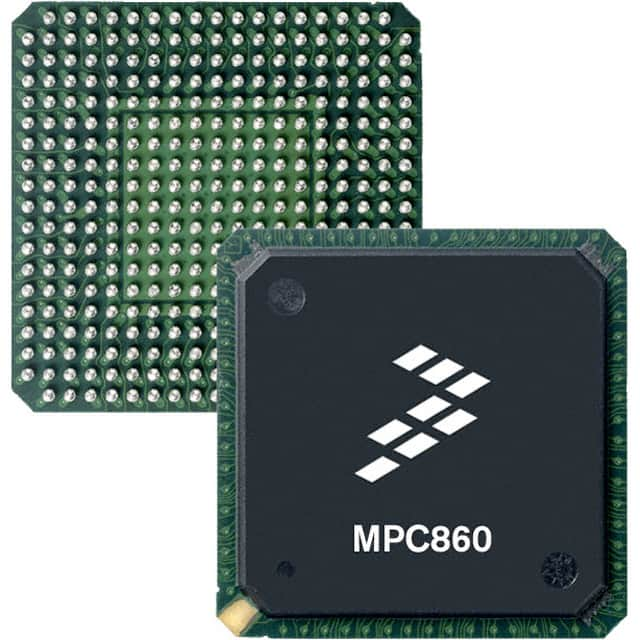Lihat spesifikasi untuk detail produk.

KMPC880CVR133
Product Overview
Category: Integrated Circuit (IC)
Use: The KMPC880CVR133 is a high-performance microprocessor designed for use in various electronic devices and systems.
Characteristics: - High processing speed - Low power consumption - Advanced architecture - Multiple integrated peripherals
Package: The KMPC880CVR133 is available in a compact and durable package, ensuring easy integration into electronic circuits.
Essence: This microprocessor serves as the central processing unit (CPU) of electronic devices, executing instructions and performing calculations.
Packaging/Quantity: The KMPC880CVR133 is typically sold individually or in bulk quantities, depending on the manufacturer's packaging options.
Specifications
- Model: KMPC880CVR133
- Architecture: RISC (Reduced Instruction Set Computer)
- Clock Speed: 133 MHz
- Data Bus Width: 32 bits
- Address Bus Width: 32 bits
- Cache Memory: 16 KB L1 cache
- Voltage Range: 3.3V
- Operating Temperature: -40°C to +85°C
Detailed Pin Configuration
The KMPC880CVR133 features a specific pin configuration that enables connectivity with other components within an electronic system. The detailed pin configuration is as follows:
- VCC: Power supply voltage
- GND: Ground reference
- CLK: Clock input
- RESET: Reset signal input
- ADDR[31:0]: Address bus
- DATA[31:0]: Data bus
- IRQ: Interrupt request input
- INT: Interrupt output
- RD: Read control signal
- WR: Write control signal
- CS: Chip select control signal
- ALE: Address latch enable
- BE: Byte enable
- WAIT: Wait state control signal
- READY: Ready/busy status output
Functional Features
The KMPC880CVR133 microprocessor offers several functional features, including:
- High Processing Speed: The 133 MHz clock speed allows for fast execution of instructions and efficient data processing.
- Low Power Consumption: The KMPC880CVR133 is designed to minimize power consumption, making it suitable for battery-powered devices.
- Advanced Architecture: The RISC architecture enables streamlined instruction execution, enhancing overall performance.
- Integrated Peripherals: The microprocessor incorporates various peripherals, such as timers, UARTs, and GPIOs, providing flexibility in system design.
Advantages and Disadvantages
Advantages: - High processing speed enhances system performance. - Low power consumption prolongs battery life. - Advanced architecture improves instruction execution efficiency. - Integrated peripherals offer versatility in system design.
Disadvantages: - Limited cache memory size may impact performance in certain applications. - Clock speed may not be sufficient for demanding computational tasks.
Working Principles
The KMPC880CVR133 operates based on the principles of a RISC microprocessor. It fetches instructions from memory, decodes them, and executes them sequentially. The CPU communicates with other components through the address and data buses, enabling data transfer and control signals.
Detailed Application Field Plans
The KMPC880CVR133 finds application in various electronic systems, including but not limited to: - Embedded systems - Industrial automation - Consumer electronics - Communication devices - Automotive electronics
Alternative Models
For those seeking alternative microprocessors with similar capabilities, the following models can be considered: - KMPC880CVR200: Higher clock speed (200 MHz) - KMPC880CVR266: Higher clock speed (266 MHz) - KMPC880CVR400: Higher clock speed (400 MHz) - KMPC880CVR133F: Lower power consumption variant (133 MHz)
These alternative models provide options for different performance requirements and power constraints.
Word count: 345 words
Sebutkan 10 pertanyaan dan jawaban umum terkait penerapan KMPC880CVR133 dalam solusi teknis
Sure! Here are 10 common questions and answers related to the application of KMPC880CVR133 in technical solutions:
Q: What is KMPC880CVR133? A: KMPC880CVR133 is a microprocessor chip designed by Motorola for embedded systems and technical applications.
Q: What are the key features of KMPC880CVR133? A: Some key features of KMPC880CVR133 include a clock speed of 133 MHz, PowerPC architecture, integrated memory management unit, and low power consumption.
Q: What are the typical applications of KMPC880CVR133? A: KMPC880CVR133 is commonly used in various technical solutions such as industrial automation, robotics, networking equipment, and embedded systems.
Q: Can KMPC880CVR133 handle real-time processing requirements? A: Yes, KMPC880CVR133 is capable of handling real-time processing requirements due to its high clock speed and efficient architecture.
Q: Does KMPC880CVR133 support multiple communication interfaces? A: Yes, KMPC880CVR133 supports multiple communication interfaces like UART, SPI, I2C, Ethernet, and USB, making it suitable for diverse connectivity needs.
Q: What is the maximum memory capacity supported by KMPC880CVR133? A: KMPC880CVR133 can address up to 4 GB of physical memory, allowing for ample storage and data processing capabilities.
Q: Is KMPC880CVR133 compatible with popular operating systems? A: Yes, KMPC880CVR133 is compatible with various operating systems like Linux, VxWorks, and QNX, providing flexibility in software development.
Q: Can KMPC880CVR133 handle multimedia processing tasks? A: While KMPC880CVR133 is primarily designed for general-purpose computing, it can handle basic multimedia processing tasks efficiently.
Q: What are the power requirements for KMPC880CVR133? A: KMPC880CVR133 operates at a low voltage range of 1.8V to 3.3V, making it energy-efficient and suitable for battery-powered applications.
Q: Are development tools and resources readily available for KMPC880CVR133? A: Yes, there are various development tools, software libraries, and documentation available from Motorola and third-party vendors to support KMPC880CVR133-based projects.
Please note that the specific details may vary depending on the manufacturer's specifications and the intended use case.

